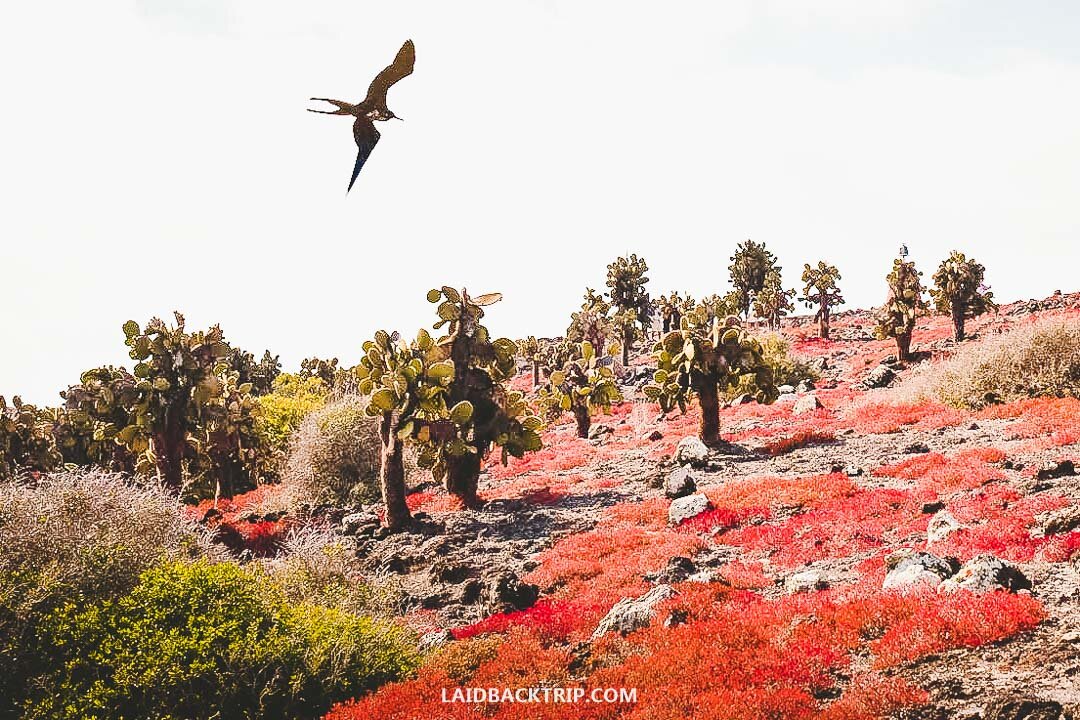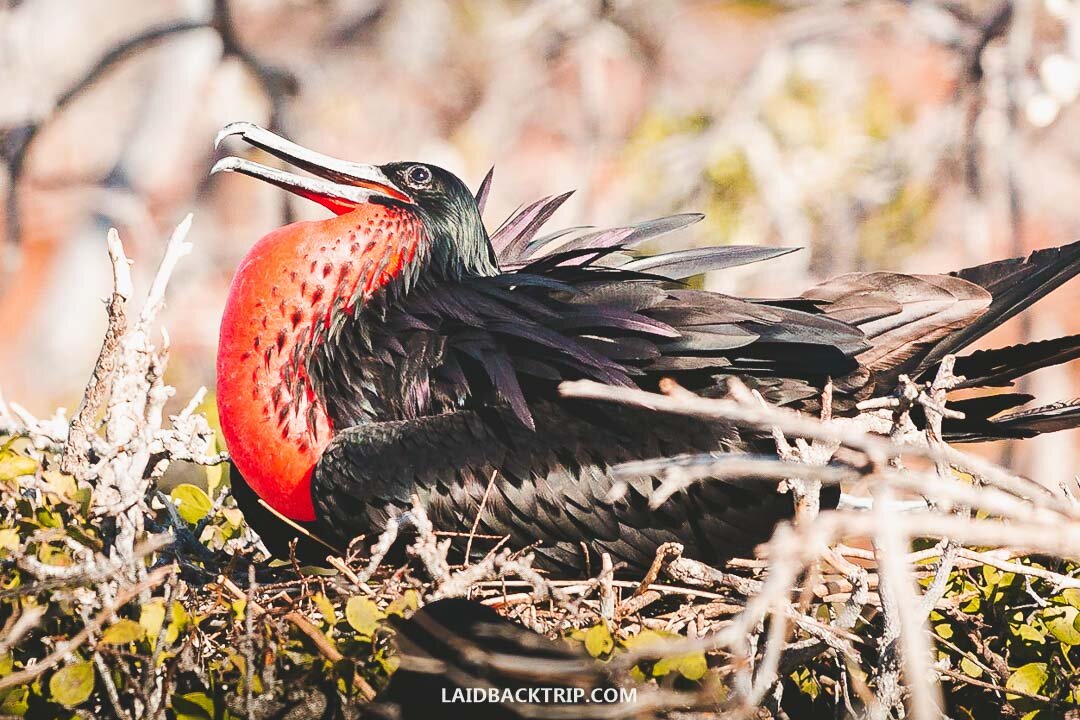21 Photos That Will Inspire You to Visit the Galapagos Islands
Galapagos Islands in Ecuador are on the top of the list of the most beautiful and sought-after destinations in the world. We have selected the 21 best photos from our recent trip to the Galapagos archipelago to inspire your wanderlust.
We have a feeling there is no need to introduce Ecuador's Galapagos Islands.
We don't know a traveler who's never dreamed about this beautiful destination, the famous archipelago, the magnificent place which inspired Charles Darwin to lay the foundations for his revolutionary evolution theory and the theory of natural selection.
The Galapagos Islands are unlike any other place on this planet, and we know that many travelers who plan on visiting the archipelago often do not know what to expect. Neither did we.
Sure, we hoped the sea would be beautiful and beaches pristine, but nothing could prepare us beforehand for the interaction with animals on the islands.
Seeing the rare species and overall, the results of evolution on secluded islands firsthand was invaluable, and traveling to the Galapagos made us think differently about our planet.
We spent one-week cruising around the Galapagos, visited many islands, saw an uncountable number of wildlife species, and took thousands of photos.
In this blog post, we've handpicked 21 best and most characteristic photos of the Galapagos Islands to inspire your wanderlust.
One of the main reasons for traveling to the Galapagos Islands is that it’s truly once in a lifetime opportunity, and no words can do justice to the beauty we could have seen around the archipelago.
Hopefully, our photos will explain it better and transport you to one of the most appealing and visually attractive destinations in the world.
Below, you can find Galapagos Islands best photos from our photo album we think represent this Ecuador's gem better than anything.
SEA LIONS
We can vividly remember the first time we saw sea lions on the Galapagos Islands. It was right after we landed on San Cristobal island when we reached the pier.
And there they were.
It was like waking up in a fairytale as this first contact with the wildlife came like thirty minutes after we landed. It was probably the moment when we realized that we appeared in one of the world's unique places and that the upcoming week will be incredible.
We knew we should see sea lions on the Galapagos a lot, but we simply could not believe they are everywhere, lying on the rocks even on the busy town's pier.
When we had free time in San Cristobal the first afternoon, we also remember how our guide told us to explore the town and not take so many photos of the sea lions because we would see them every day during the next week.
Guess what all of us did and where we met the rest of our group. A small hint: sea lions are so damn cute.
BLUE-FOOTED BOOBIES
Usually, watching and photographing birds is not that exciting because they are often too far from us, but again, the Galapagos Islands are exceptional when it comes to wildlife watching.
Blue-footed boobies are one of the favorite bird species among travelers; not only it is incredible to see their blue feet up close, but during thousands of years, they also developed a pretty unique style of hunting.
So with a bit of luck, it is worthwhile to see them in flight as well.
Their hunting style is called dive-bombing, and you need to see this with your own eyes and maybe use even binoculars to fully appreciate the fishing technique.
It is quite terrifying, actually.
SUNSETS
The visit to the Galapagos Islands is a whole package; from the morning to the evening, there was always something interesting to see and do.
And when we finally wanted to take a break on our boat's upper deck, we could see sunsets like this one.
During our seven-day cruise, it became a habit that all passengers met around sunset time to watch the sky turn yellow, orange, and red.
We even asked the crew if it is possible to postpone dinner a bit so we won't miss a single sunset when cruising around the archipelago.
SUNRISES
It cannot take you by surprise by now that sunrises on the Galapagos Islands are as beautiful as sunsets. No matter if you are traveling on a cruise or travel independently, it is worth it to get up early and wait for the first sunlight.
We visited the Galapagos in September, and during this time was sunrise quite late, so we did not have to get up super early to enjoy the show.
BEACHES
Under normal circumstances, beaches on the Galapagos Islands would have been the reason number one why to travel there, but the Galapagos is not a typical destination.
But if you'll have a moment between snorkeling, admiring the amazing landscape, and looking for wildlife, try to slow down a bit and enjoy walking and relaxing on pristine sandy beaches.
It is yet another experience; there is only one rule. You need to watch out for sea lions lazing around, especially for the big alpha males.
IGUANAS
Completely motionless, iguanas are another iconic animal species for the Galapagos.
They are so still and so photogenic that we could have stood there for hours and watched the colonies of iguanas warming up on the sun.
It is interesting that the marine iguanas can be found only on the Galapagos Islands - yet another reason to visit.
You don't need to be a biologist to appreciate the exceptionality of these unique lizards fully. Iguanas are very photogenic, and they are also very popular among amateur photographers because they can hold still for a long time.
ALBATROSSES
Galapagos Islands is a unique environment, and visitors must follow many strict rules. One of the rules is that everyone must walk only on well-designated paths; no one can wander around freely.
The only exceptions are when you find mating albatrosses sitting right in the middle of the trail. It just never ceased to amaze us how animals reacted to our presence.
They simply do not have coded in the genes that human is a dangerous species.
FLAMINGOS
You probably cannot take a more cheesy photo in South America than a picture of flamingo's silhouettes reflecting in the lagoon.
Seeing flamingoes on the Galapagos Islands is always hit or miss.
It depends on when you travel around the archipelago, so we were quite lucky to spot a colony of adults and chicks who don't have the typical reddish color yet.
TURTLES AND TORTOISES
One of the most iconic animals on the Galapagos Islands are giant turtles, officially named Galapagos giant tortoise.
Although tortoises don't have any natural predators, the number of turtles dropped significantly from the 16th century when Spaniards discovered the archipelago.
It took only a few centuries, and instead of 250 000 tortoises were here suddenly only about 3 000 of them! The main reason behind the huge drop was hunting for meat and oil and introducing non-native animals to the islands.
Nowadays, most of the programs' goal is to increase the number of tortoises on the Galapagos. We were so grateful we could see the giants both in the wild and sanctuaries
FISH MARKET
Sometimes we found the most interesting moments without expecting them.
When we were walking from Charles Darwin Research Center and thought we saw enough highlights for the day, we stumbled across a local fish market by accident.
Fishermen just arrived from the sea and brought a lot of fish to the market, which was basically a small tiled space next to the pier.
Local people came immediately to buy fresh meat either for themselves or their businesses, and birds flew around to steal what was left.
Pretty cool, although a bit smelly experience.
VOLCANIC LANDSCAPES
The Galapagos Islands are not only about the wildlife but also the landscape is pretty unique.
The archipelago consists of volcanic islands, and the volcanic activity and eruptions created a very photogenic scenery.
Nowadays, it is safe to visit the archipelago, but when creating your Galapagos packing list, make sure to make a note to bring hiking boots as some of the trails lead across volcanic fields that are very sharp.
VIEWPOINTS
We had to climb only 400 steps to get to the most scenic and the most photographed place (landscape-wise) in the Galapagos Islands on Bartolome Island.
We are pretty sure you've seen this photo before, and in case you want to see it yourself, make sure that your Galapagos itinerary includes it.
It was actually one of the photos that inspired us to visit this place, at the time when we just started our South American journey and had not been yet decided if our budget allows us to include this Ecuador's destination in our travel plan.
Bartolome Island is a volcanic island with harsh conditions.
Still, the climb is well worth it as you can see how the slope of lava covered with vegetation slowly descends into the water with the Pinnacle Rock in the background.
PENGUINS
Back in the days, we lived for 15 months in New Zealand, and we vividly remember the moment when we saw a small penguin walking alone across a beach the same way as in cartoons for kids, and we thought we would never see anything that cute anymore.
Well, these Galapagos penguins surely deserve the shared first place.
UNEXPECTED MOMENTS
What we loved the most about the Galapagos was how authentic some situations were and that we must have ready our camera all the time.
Unexpected situations are part of everyday life. The reason behind it is simple and comes from the constant interaction with animals that are proud to call this place home.
When it comes to wildlife, the Galapagos Islands are a paradise for photographers.
Consider bringing a good mirrorless camera with a proper telephoto lens that will help you capture some of the most incredible moments.
CIRCLE OF LIFE
The circle of life is an unstoppable force. When exploring the islands, we could see blood on the ground, sometimes even a placenta before birds ate it, so we knew life for someone has just begun.
We also saw dead sea lions or their skeletons on the beaches or broken eggs of chicks who would never reach adult life.
The Galapagos Islands are raw, true, and show its visitors the circle of life without any pretensions.
Everything has a meaning, every animal and plant has a purpose, and the death of one can mean life for another.
RED ISLAND
South Plazas is a small island, which is absolutely gorgeous.
Despite its small size, the island is home to many animals such as different species of birds or land iguanas who coexist here in this harsh environment where the majority of flora consists of cacti trees and sesuvium plant, which changes color depending on the season.
The contrast of cacti trees and red plants was so photogenic.
As you can see, inspiring photo opportunities wait behind every corner, so make sure you have spare batteries for your camera and enough memory cards.
FRIGATES
Frigate birds look pretty inconspicuous until the breeding season comes. During this time, males inflate a red throat sack to attract females.
And we can tell, the sight attracted not only females in our group.
CRABS
Some animals on the Galapagos islands developed during thousands of years great camouflage strategies. They often can stand still, or their coloring is so perfect you cannot recognize them when hiding in their natural habitat.
But this crab has an absolutely opposite strategy.
His bright red color says to his enemies he is dangerous or poisonous, so he can fearlessly walk around.
UNDERWATER LIFE
Underwater life in the Galapagos is as interesting as the life above water.
So despite the fact, the ocean was freezing cold during our visit, and we had to wear a wetsuit all the time, we couldn't wait to jump into the water and swim with sea lions, turtles, different species of fish and even sharks!
If there's only one thing we regret, it is that we did not have a GoPro or any other action camera with us, and we could not capture any underwater photos.
On the other hand, it was the only time we could leave the camera behind and just enjoy the moment during our trip.
Travel Insurance
We never leave home without travel insurance that was designed to cover our expenses if something goes wrong during the trip.
Travel insurance protects against theft, flight delays, injury, illness, cancellations, and much more.
World Nomads provides travel insurance for travelers to cover their trip essentials, including sports and adventure activities.
SafetyWing is affordable travel insurance for backpackers, long-term travelers, and digital nomads.
Travel smarter and safer!
KICKER ROCK
One of the most popular landmarks in the Galapagos archipelago is Lion's Rock, alias Kicker Rock towering out of the water.
Some people say it looks like a sleeping lion when viewing it from the south; some people say it looks like a boot.
Evidently, it depends on the point of view. Either way, the rock is pretty exceptional, and it is one of the most impressive formations on the Galapagos.
NATURE
We had always thought the wildlife is the only reason why to travel to the Galapagos Islands.
Well, we don't think it anymore. Wildlife and nature go here hand in hand, and when we were going through our photos from this trip, we could not decide what amazed us the most.
So this is it.
The collection of our favorite photos from the Galapagos Islands that, in short, sum up some of the things you can expect to see there.
In case you plan your trip on a budget, make sure you check our post on Where to stay on the Galapagos Islands.
Travel Resources
Here you can find links to all the travel resources we use and which you might find helpful when planning your next holiday.
Accommodation: When looking for accommodation, we usually search hotels via Booking.com or Hostelworld.
Tours: Although we love to travel independently, some places are better to visit with a guided tour.
We prefer GetYourGuide for its easy-to-use interface and solid reputation. Another great alternative is Viator.
Rental Cars: When going on a road trip, we always use Rentalcars.com, a reliable site for booking a rental car in advance.
Flight Tickets: When looking for flight tickets, you can search Skyscanner to find the best price.
Travel Insurance: World Nomads and SafetyWing cover against risks of travel.



























